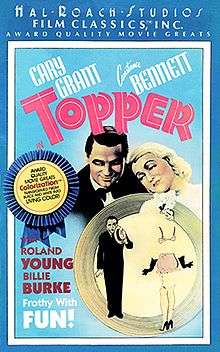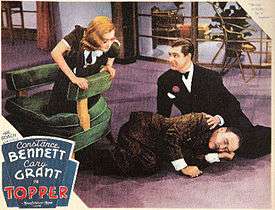Topper (film)
| Topper | |
|---|---|
|
Lobby card | |
| Directed by | Norman Z. McLeod |
| Produced by | Hal Roach |
| Screenplay by |
Jack Jevne Eric Hatch Eddie Moran |
| Based on |
Topper (1926 novel) by Thorne Smith |
| Starring |
Constance Bennett Cary Grant |
| Music by | Marvin Hatly |
| Cinematography | Norbert Brodine |
| Edited by | William H. Terhune |
| Distributed by | Metro-Goldwyn-Mayer |
Release dates |
|
Running time | 97 minutes |
| Country | United States |
| Language | English |
| Budget | $500,000 (proposed)[1] |
Topper (1937) is an American supernatural comedy film starring Constance Bennett and Cary Grant and featuring Roland Young, which tells the story of a stuffy, stuck-in-his-ways man, Cosmo Topper (Roland Young) who is haunted by the ghosts of a fun-loving married couple.
The film was adapted by Eric Hatch, Jack Jevne and Eddie Moran from the novel by Thorne Smith. The movie was directed by Norman Z. McLeod, produced by Hal Roach, and distributed by Metro-Goldwyn-Mayer. The supporting cast includes Billie Burke and Eugene Pallette. Topper was a huge hit with film audiences in the summer of 1937; since Cary Grant had a percentage deal on the film, he made quite a bit of money on the film's success.
Topper was the first black-and-white film to be digitally colorized, re-released in 1985 by Hal Roach Studios.[2]
Plot
George (Cary Grant) and Marion (Constance Bennett) Kerby are as rich as they are irresponsible. When George wrecks their classy sports car, they wake up from the accident as ghosts. Realizing they aren’t in heaven or hell because they’ve never been responsible enough to do good deeds or bad ones, they decide that freeing their old friend Cosmo Topper (Roland Young) from his regimented lifestyle will be their ticket into heaven.
Topper, a wealthy bank president, is trapped in a boring job. Worse still, Clara (Billie Burke), his social-climbing wife, seems to care only about nagging him and presenting a respectable façade. On a whim, after George and Marion die, Topper buys George’s flashy sports car. Soon he meets the ghosts of his dead friends, and immediately they begin to liven up his dull life with drinking and dancing, flirting and fun.
The escapades lead quickly to Cosmo’s arrest, and the ensuing scandal alienates his wife Clara, however some of the people Clara would like to socialize with now because of Topper's scandal become interested in her and Topper. Cosmo moves out into a hotel with Marion who claims she is no longer married since she is dead. Clara fears she has lost Cosmo forever. The Toppers' loyal butler suggests that she lighten up a bit; she decides he’s right and dons the lingerie and other attire of “a forward woman.” After Cosmo has a near-death experience and nearly joins George and Marion in the afterlife, Cosmo and Clara are happily reunited, and George and Marion, their good deed done, gladly depart for heaven.
Cast
|
|
Cast notes
- Songwriter and pianist Hoagy Carmichael makes an uncredited cameo appearance, early in the film, as the piano player in the sequence where George and Marion are on the town the night before the meeting at the bank. He introduces the song "Old Man Moon", which is sung by Grant and Bennett (It's also sung later by Three Hits and a Miss).[3] It was Carmichael's screen debut.[3] As the couple leave the bar, George (Grant) says, "(Good)night Hoagy!", and Carmichael replies "So long, see ya next time."
Production
After a long career producing comedy shorts, producer Hal Roach was looking to expand into long-form films, and found a property in The Jovial Ghosts, a semi-risqué 1926 novel by Thorne Smith. Roach immediately wanted Cary Grant to play George Kerby, but he had difficulty getting the actor to agree to play the part, since Grant was concerned about the supernatural aspects of the story. Assurance from Roach that the screwball aspects of the story would be played up – plus a fee of $50,000 – were sufficient to convince Grant to do the film.[4]
For Grant's opposite number, Roach was interested in Jean Harlow, and as Topper W. C. Fields, but Harlow was too ill, and Fields turned down the offer. When Roach reached out to Constance Bennett, she was impressed enough with the property that she agreed to be paid less than her usual $40,000 fee.[4]
Topper was shot at Hal Roach Studios in Culver City,[5] and location shooting took place at the entrance to the Bullock's department store on Wilshire Boulevard – as the entrance to the "Seabreeze Hotel"[1] – and at a location on San Rafael Avenue in Pasadena, California.[5]
The automobile used by George and Marion Kerby, before they become ghosts, and later by Cosmo Topper – whose own car is a 1936 Lincoln Model K – is a custom-made vehicle with a resemblance to Cord and Duesenberg automobiles of the 1930s. Production models of a Cord were too small to use, so the custom body was built on the chassis of a 1936 Buick Roadmaster by Bohman & Schwartz Co., and the external exhaust pipes characteristic of a supercharged Cord are non-functional; the Buick Roadmaster of the time used an eight-in-line ("straight eight") engine whereas the Cord used a V-8 engine- so external exhaust pipes on both sides of the hood (as per the Cord arrangement) would have meant that at least one side of the car (and probably both) used dummy external pipes. The Buick trunk had special compartments for camera equipment. Afterwards, the car was purchased by the Gilmore Oil Co., who used it for many years for promotional purposes. In 1954, the vehicle was updated utilizing a Chrysler Imperial chassis and drive train.[6][7]
Reception
Topper was a box-office hit, and gave a boost to the careers of all the lead actors, in particular Cary Grant, who moved from this film into a series of classic screwball comedies such as The Awful Truth (1937), Bringing Up Baby (1938), and Holiday (1938).[8] Constance Bennett – who had previously been known as more of a "clothes-horse" than an actress – received very good notices, and Roach reunited her with director McLeod and screenwriters Jevne and Moran – was well as Billie Burke and Alan Mowbray – for 1938's Merrily We Live.[8]
Awards and honors
Topper was nominated for Academy Awards for Best Actor in a Supporting Role for Roland Young – his only nomination – and Best Sound, Recording for Elmer A. Raguse.[9]
The film is recognized by American Film Institute in these lists:
- 2000: AFI's 100 Years... 100 Laughs - #60[10]
- 2008: AFI's 10 Top 10:
- Nominated Fantasy Film[11]
Sequels and adaptations
Topper was followed by the sequels Topper Takes a Trip (1938)[12] and Topper Returns (1941).[13]
There was a television series,[14] which premiered in 1953 and ran for two seasons, starring Leo G. Carroll, Robert Sterling and Anne Jeffreys. In 1973, a television pilot for a proposed new series Topper Returns (1973)[15] was produced, starring Roddy McDowall, Stefanie Powers and John Fink. A TV movie remake, Topper (1979)[16] was also produced starring Kate Jackson, Jack Warden and Andrew Stevens. Nearly Departed, a short-lived American TV series of the 1980s starring Eric Idle of Monty Python fame, was based on the same premise.
Colorization

Topper was the first black-and-white film to be digitally colorized, re-released in 1985 by Hal Roach Studios, with color by Colorization, Inc.[2] The film was chosen because its original 1937 release represented Hal Roach's entry into major feature film production. "In light of this history, it seems fitting that Topper should again be on the cutting edge of change," the studio stated, "this time heralding the age of Colorization as the first completed Color version of a classic black and white motion picture."[17]
See also
References
- 1 2 "Notes" on TCM.com
- 1 2 "Topper". AFI Catalog of Feature Films. American Film Institute. Retrieved 2016-06-28.
- 1 2 "Topper" (articles) on TCM.com
- 1 2 Miller, Frank. "Topper" (article) on TCM.com
- 1 2 "Topper (1937) - Filming locations" at the Internet Movie Database
- ↑ Strohl, Daniel. "SIA Flashback – The Topper Buick’s Many Metamorphoses" Hemming's Daily (February 20, 2011)
- ↑ "Trivia" TCM.com
- 1 2 Miller, John M. "Topper" (article) on TCM.com
- ↑ "The 10th Academy Awards (1938) Nominees and Winners". oscars.org. Retrieved 2011-08-10.
- ↑ "AFI's 100 Years...100 Laughs" (PDF). American Film Institute. Retrieved 2016-08-06.
- ↑ "AFI's 10 Top 10 Nominees" (PDF). Retrieved 2016-08-19.
- ↑ Topper Takes a Trip at the Internet Movie Database
- ↑ Topper Returns at the Internet Movie Database
- ↑ Topper at the Internet Movie Database
- ↑ Topper Returns at the Internet Movie Database
- ↑ Topper at the Internet Movie Database
- ↑ Hal Roach Studios, Inc. (1985). Topper (Media notes). Hal Roach Studios Film Classics, Inc.
External links
| Wikimedia Commons has media related to Topper (film). |
- Topper at the Internet Movie Database
- Topper at AllMovie
- Topper at Turner Classic Movies
- Topper at the American Film Institute Catalog
- Topper review at TVGuide.com
- Topper historic reviews, photo gallery at CaryGrant.net
- Watch Topper at the Internet Archive
- Hemmings Daily blog: SIA Flashback - The Topper Buick's Many Metamorphoses
